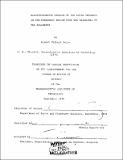Electromagnetic probing of the lunar interior in the frequency region from one kilohertz to ten kilohertz
Author(s)
Reisz, Albert Colbert
DownloadFull printable version (1.492Mb)
Other Contributors
Massachusetts Institute of Technology. Dept. of Earth and Planetary Sciences.
Advisor
Theodore R. Madden.
Terms of use
Metadata
Show full item recordAbstract
For probable values of the lunar electromagnetic properties, a transverse magnetic surface wave may be propagated along the solar wind plasma-moon interface in the frequency range from about one kilohertz to about ten kilohertz. The horizontal propagation characteristics of this surface wave as a function of frequency may be used to probe the lunar electromagnetic properties to a probable maximum depth of about fifty kilometers. The electromagnetic fields of idealized dipole sources located within a few meters of the lunar surface and immersed in the solar wind plasma are considered. For a vertical electric dipole, or broadside to a horizontal magnetic dipole, the surface fields at radial distances greater than about ten kilometers are found to be dominated by the surface wave. These sources may also excite transverse magnetic wave guide modes confined between the plasma and a lunar conducting basement. If a wet model of the moon is adopted, only the surface wave mode will be present, and it will be sensitive to the depth of the ice to water transition, expected at about one kilometer, and to lunar dielectric properties between the transition depth and the surface. If the moon is dry, a thermally activated conductive basement is expected at about one hundred kilometers, and the surface wave will be sensitive to dielectric properties to a probable maximum depth of about fifty kilometers. For the dry model, the fields due to the wave guide modes become important below about two kilohertz for the horizontal magnetic dipole source.
Description
Thesis (M.S.)-- Massachusetts Institute of Technology, Dept. of Earth and Planetary Sciences, 1970. Includes bibliographical references (leaf 37).
Date issued
1970Department
Massachusetts Institute of Technology. Department of Earth, Atmospheric, and Planetary SciencesPublisher
Massachusetts Institute of Technology
Keywords
Earth and Planetary Sciences.